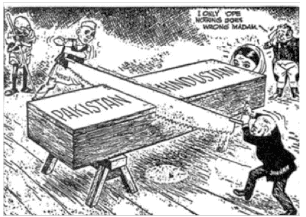Humanities/Arts Exam > Humanities/Arts Questions > Study the cartoon carefully and give the ans...
Start Learning for Free
Study the cartoon carefully and give the answers to the question that follows:

Q. Which two states were undecided to be part of either of these countries, at the time of partition?
- a)Travancore and Hyderabad
- b)Gujarat and Haryana
- c)Madhya Pradesh and Bengal
- d)Assam and Bengal
Correct answer is option 'A'. Can you explain this answer?
Most Upvoted Answer
Study the cartoon carefully and give the answers to the question that...
At the time of Independence, Britishers announced that with the end of their rule over India, all princely states were free to join either India or Pakistan or remain independent if they so wished.

|
Explore Courses for Humanities/Arts exam
|

|
Similar Humanities/Arts Doubts
Study the cartoon carefully and give the answers to the question that follows:Q. Which two states were undecided to be part of either of these countries, at the time of partition?a)Travancore and Hyderabadb)Gujarat and Haryanac)Madhya Pradesh and Bengald)Assam and BengalCorrect answer is option 'A'. Can you explain this answer?
Question Description
Study the cartoon carefully and give the answers to the question that follows:Q. Which two states were undecided to be part of either of these countries, at the time of partition?a)Travancore and Hyderabadb)Gujarat and Haryanac)Madhya Pradesh and Bengald)Assam and BengalCorrect answer is option 'A'. Can you explain this answer? for Humanities/Arts 2025 is part of Humanities/Arts preparation. The Question and answers have been prepared according to the Humanities/Arts exam syllabus. Information about Study the cartoon carefully and give the answers to the question that follows:Q. Which two states were undecided to be part of either of these countries, at the time of partition?a)Travancore and Hyderabadb)Gujarat and Haryanac)Madhya Pradesh and Bengald)Assam and BengalCorrect answer is option 'A'. Can you explain this answer? covers all topics & solutions for Humanities/Arts 2025 Exam. Find important definitions, questions, meanings, examples, exercises and tests below for Study the cartoon carefully and give the answers to the question that follows:Q. Which two states were undecided to be part of either of these countries, at the time of partition?a)Travancore and Hyderabadb)Gujarat and Haryanac)Madhya Pradesh and Bengald)Assam and BengalCorrect answer is option 'A'. Can you explain this answer?.
Study the cartoon carefully and give the answers to the question that follows:Q. Which two states were undecided to be part of either of these countries, at the time of partition?a)Travancore and Hyderabadb)Gujarat and Haryanac)Madhya Pradesh and Bengald)Assam and BengalCorrect answer is option 'A'. Can you explain this answer? for Humanities/Arts 2025 is part of Humanities/Arts preparation. The Question and answers have been prepared according to the Humanities/Arts exam syllabus. Information about Study the cartoon carefully and give the answers to the question that follows:Q. Which two states were undecided to be part of either of these countries, at the time of partition?a)Travancore and Hyderabadb)Gujarat and Haryanac)Madhya Pradesh and Bengald)Assam and BengalCorrect answer is option 'A'. Can you explain this answer? covers all topics & solutions for Humanities/Arts 2025 Exam. Find important definitions, questions, meanings, examples, exercises and tests below for Study the cartoon carefully and give the answers to the question that follows:Q. Which two states were undecided to be part of either of these countries, at the time of partition?a)Travancore and Hyderabadb)Gujarat and Haryanac)Madhya Pradesh and Bengald)Assam and BengalCorrect answer is option 'A'. Can you explain this answer?.
Solutions for Study the cartoon carefully and give the answers to the question that follows:Q. Which two states were undecided to be part of either of these countries, at the time of partition?a)Travancore and Hyderabadb)Gujarat and Haryanac)Madhya Pradesh and Bengald)Assam and BengalCorrect answer is option 'A'. Can you explain this answer? in English & in Hindi are available as part of our courses for Humanities/Arts.
Download more important topics, notes, lectures and mock test series for Humanities/Arts Exam by signing up for free.
Here you can find the meaning of Study the cartoon carefully and give the answers to the question that follows:Q. Which two states were undecided to be part of either of these countries, at the time of partition?a)Travancore and Hyderabadb)Gujarat and Haryanac)Madhya Pradesh and Bengald)Assam and BengalCorrect answer is option 'A'. Can you explain this answer? defined & explained in the simplest way possible. Besides giving the explanation of
Study the cartoon carefully and give the answers to the question that follows:Q. Which two states were undecided to be part of either of these countries, at the time of partition?a)Travancore and Hyderabadb)Gujarat and Haryanac)Madhya Pradesh and Bengald)Assam and BengalCorrect answer is option 'A'. Can you explain this answer?, a detailed solution for Study the cartoon carefully and give the answers to the question that follows:Q. Which two states were undecided to be part of either of these countries, at the time of partition?a)Travancore and Hyderabadb)Gujarat and Haryanac)Madhya Pradesh and Bengald)Assam and BengalCorrect answer is option 'A'. Can you explain this answer? has been provided alongside types of Study the cartoon carefully and give the answers to the question that follows:Q. Which two states were undecided to be part of either of these countries, at the time of partition?a)Travancore and Hyderabadb)Gujarat and Haryanac)Madhya Pradesh and Bengald)Assam and BengalCorrect answer is option 'A'. Can you explain this answer? theory, EduRev gives you an
ample number of questions to practice Study the cartoon carefully and give the answers to the question that follows:Q. Which two states were undecided to be part of either of these countries, at the time of partition?a)Travancore and Hyderabadb)Gujarat and Haryanac)Madhya Pradesh and Bengald)Assam and BengalCorrect answer is option 'A'. Can you explain this answer? tests, examples and also practice Humanities/Arts tests.

|
Explore Courses for Humanities/Arts exam
|

|
Signup for Free!
Signup to see your scores go up within 7 days! Learn & Practice with 1000+ FREE Notes, Videos & Tests.
























